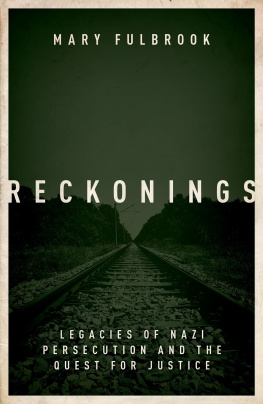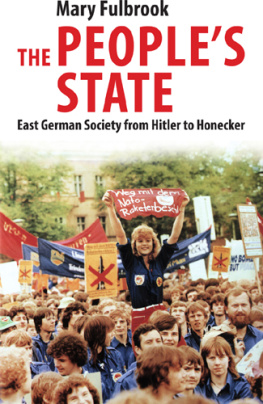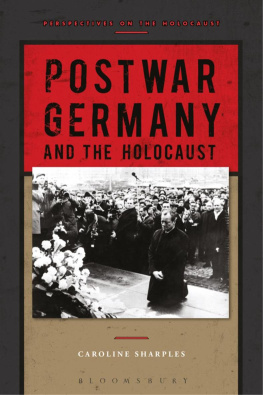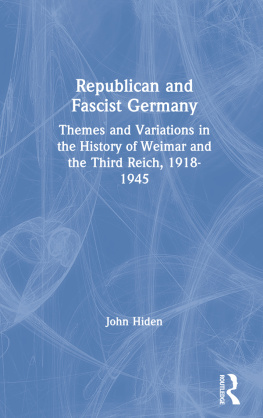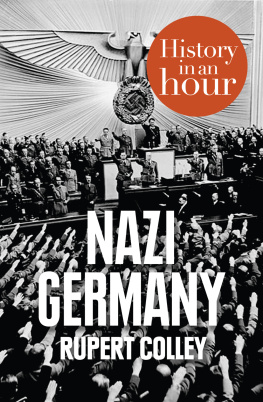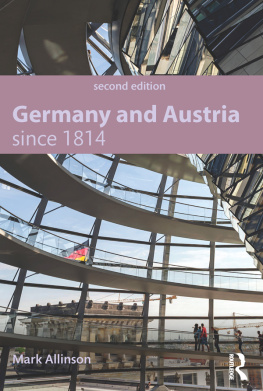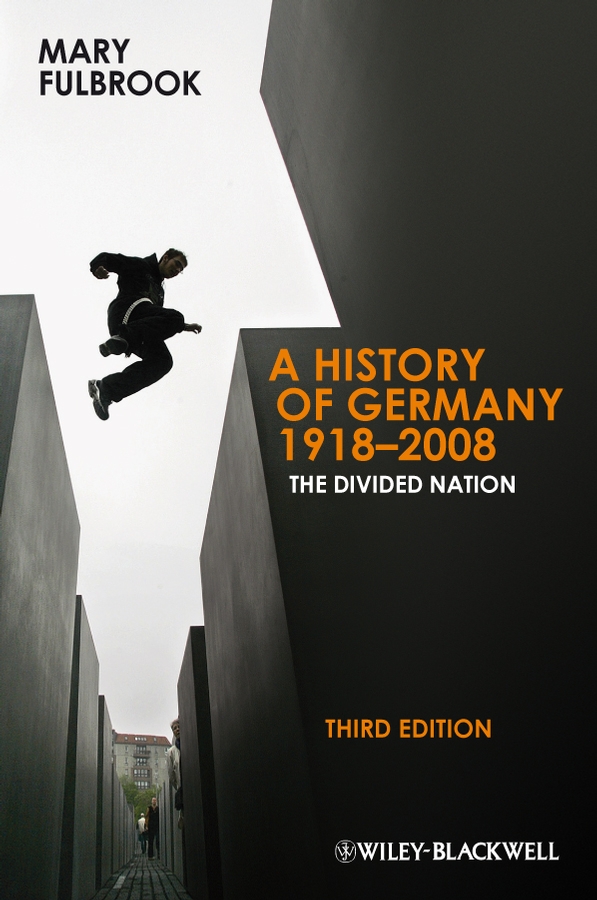
This third edition first published 2009
2009 by Mary Fulbrook
Edition history: Fontana Ltd (1e, 1991); Blackwell Publishing Ltd (2e, 2002)
Blackwell Publishing was acquired by John Wiley & Sons in February 2007.
Blackwells publishing program has been merged with Wileys global Scientific, Technical, and Medical business to form Wiley-Blackwell.
Registered Office
John Wiley & Sons Ltd, The Atrium, Southern Gate, Chichester, West Sussex, PO19 8SQ, United Kingdom
Editorial Offices
350 Main Street, Malden, MA 02148-5020, USA
9600 Garsington Road, Oxford, OX4 2DQ, UK
The Atrium, Southern Gate, Chichester, West Sussex, PO19 8SQ, UK
For details of our global editorial offices, for customer services, and for information about how to apply for permission to reuse the copyright material in this book please see our website at www.wiley.com/wiley-blackwell.
The right of Mary Fulbrook to be identified as the author of this work has been asserted in accordance with the Copyright, Designs and Patents Act 1988.
All rights reserved. No part of this publication may be reproduced, stored in a retrieval system, or transmitted, in any form or by any means, electronic, mechanical, photocopying, recording or otherwise, except as permitted by the UK Copyright, Designs and Patents Act 1988, without the prior permission of the publisher.
Wiley also publishes its books in a variety of electronic formats. Some content that appears in print may not be available in electronic books.
Designations used by companies to distinguish their products are often claimed as trademarks. All brand names and product names used in this book are trade names, service marks, trademarks or registered trademarks of their respective owners. The publisher is not associated with any product or vendor mentioned in this book. This publication is designed to provide accurate and authoritative information in regard to the subject matter covered. It is sold on the understanding that the publisher is not engaged in rendering professional services. If professional advice or other expert assistance is required, the services of a competent professional should be sought.
Library of Congress Cataloging-in-Publication Data
Fulbrook, Mary, 1951
History of Germany, 19182008 : the divided nation / Mary Fulbrook. 3rd ed.
p. cm.
Previously published under the title: The divided nation.
Includes bibliographical references and index.
ISBN 978-1-4051-8814-2 (pbk. : alk. paper) 1. GermanyPolitics and government20th century. I. Fulbrook, Mary, 1951 Divided nation. II. Title.
DD240.F85 2009
943.087dc22
2008038570
A catalogue record for this book is available from the British Library.
Plates
Unemployed dock-workers in January 1931
Hitlers triumphal arrival to popular acclaim in his former home town of Linz, during the 1938 Anschluss of Austria (which subsequently represented itself as Hitlers first victim)
German soldiers execute partisans, Lithuania, 1944
Jews in the Warsaw Ghetto, who, if they survived the misery, hunger and sickness of ghetto life, would ultimately be transported and murdered in an extermination camp
West German Chancellor Konrad Adenauer looks uncomfortable on a visit to Berlins Brandenburg Gate, in August 1961, a week after the Berlin Wall was erected
Schoolchildren on their weekly day in industry in the peoples own factory with which their school is twinned, admire the progress board in the competition for fulfilment of the plan
Couple watching television, Er magazine cover, 1952
East Berliners hack out mementoes from the now defunct Berlin Wall, in the spring of 1990
Stolpersteine pavement cobblestones to stumble over, commemorating former Jewish inhabitants who were deported and murdered by the Nazis
The Memorial to the Murdered Jews of Europe, in the heart of Berlin, spreading over several acres between the Brandenburg Gate and the site of Hitlers bunker, and providing an inescapable and controversial reminder of the Jewish victims of Nazism
Maps
The Versailles settlement, 1919
The electoral performance of the NSDAP
The Reichstag elections, 5 March 1933
Territorial annexation, 19351939
The partition of Poland, 1939
Hitlers empire by autumn 1942
Major concentration camps, including extermination centers
Proportions of Europes Jewish population murdered in the Final Solution
The division of Germany after 1945
United Germany, 1990
Preface to the Third Edition
In making revisions for the third edition, I have added a separate chapter on Germany since unification, and have substantially updated the bibliography. In some sections of the book, I have also amended the text where I felt that there were significant omissions, or where the historiography has moved on so much that my previous remarks could not be left untouched. In making revisions, however, I have again had to resist the temptation to write a substantially new book, and have left the original lines of argument and organization intact.
Preface to the Second Edition
Revising this work for a second edition, ten years after its first appearance, has proved an interesting experience. I first completed the original manuscript as the GDR was in the process of implosion and collapse; I hung onto the manuscript, writing the chapter on the revolution and unification as events actually unfolded in the course of 198990. Not only was there no secondary literature at this time on the immediate events of 198990; there was also remarkably little of any depth on the longer course of GDR history, polarized as this field was between state-sanctioned MarxistLeninist accounts in the East and a predominance of rather narrowly institutional, occasionally speculative political science analyses in the West, alongside dissident critiques and ambiguous literary interpretations. With the opening of the East German archives in the early 1990s this situation has now radically changed. There is a flourishing field of GDR historical research, with the emergence of whole new areas of inquiry, lively debates and conflicting interpretations. Meanwhile, research on the Third Reich has also moved on significantly, although perhaps given the scale of what was already happening in this most controversial field before 1990 proportionately less dramatically. While there have also been shifts of emphasis in the fields of the Weimar Republic and pre-1990 West German history, particularly in areas of social history and in studies seeking to cross the 1945 divide, these have perhaps not produced such a radically new intellectual landscape on the scale of that for the GDR.
I have therefore made willfully lopsided corrections to the original edition of this work. I have made amendments to those parts of the text which deal with areas where debates have moved on significantly in ways which cannot be ignored. I have added a brief epilogue to chapter 13 on Germany since unification. I have substantially updated what remains a stringently selective bibliography, in order to guide readers towards further reading in English on areas which could not be discussed more extensively in the text. But I have resisted the temptation to add too many minor amendments throughout the text which, by seeking to recognize recent research findings and accommodate all the current concerns of academia, would have effectively unbalanced the general lines of the original narrative. I have also resisted the temptation to embark on major rewriting in areas where I now would approach questions rather differently, which could in effect have turned this into a whole new book (and I am mindful of the question of whether a bicycle which, after having a total overhaul, from brakes, chain, pedals, gears and saddle to new forks and frame, is still the same bicycle as the original). It also seems important to ensure that the historiographical as well as historical watershed of 1990 does not result in obscuring some of the major issues and perspectives which remain important. I am thus acutely conscious of the fact that I have not been able to do full justice, within the constraints of a volume of this length, to all the research that has appeared since the first edition. I can only hope that readers will be stimulated to follow some of the suggestions in the notes and bibliography to explore in greater depth topics which I have not been able to cover more fully in this particular compass.



